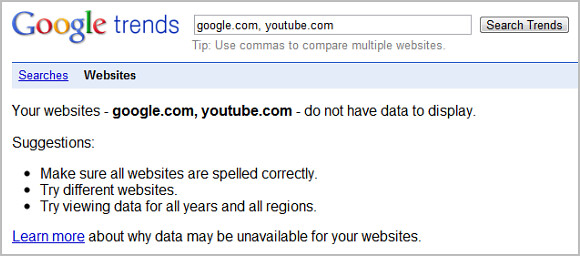 Google is a bit of a paradox. On one hand, it promotes openness, with a stated mission to “organize the world’s information and make it universally accessible and useful.” An admirable goal. On the other hand Google is often secretive when it comes to publicly sharing information about its own websites and services.
Google is a bit of a paradox. On one hand, it promotes openness, with a stated mission to “organize the world’s information and make it universally accessible and useful.” An admirable goal. On the other hand Google is often secretive when it comes to publicly sharing information about its own websites and services.
Nowhere is this more obvious than in Google’s own public data tools. Try getting information about Google websites in any of these tools and you will notice that most of this information is nowhere to be found. You’ll be able to find information about any website on the Internet, but not Google’s own.
Examples of how Google blocks its own sites
Here are a few examples that we know of:
- Google Trends for Websites – Will not let you view traffic trends for Google.com or any of its country-specific versions, or for Youtube.com.
- Google Ad Planner (a.k.a. DoubleClick Ad Planner) – Will not let you view traffic or demographics data for Google sites such as Google.com and Youtube.com.
- Google’s list of the 1,000 most-visited websites – This list contains visitor and page view information for the top websites, but doesn’t include Google.com (or its country-specific versions) or Youtube.com.
There is a certain irony here; many of Google’s own tools are Google-free zones.
Just look at this:

The regular Google Trends, the one for search stats, doesn’t block you from viewing search trends for words such as “Google”, but apparently Google draws the line at site stats.
Why?
Turning to Google’s own help pages for its tools doesn’t enlighten us much. Here’s an example from Google’s Trends for Websites (emphasis below added by us):
Not all websites are included in Trends for Websites. The following types of websites may not appear in the tool:
- Websites with low traffic volume below our threshold
- Websites that don’t wish to be indexed by Google and have indicated their preference through a robots.txt exclusion file
- Websites that don’t adhere to our Quality Guidelines
- Other websites for miscellaneous reasons
It’s like there’s an elephant in the room and Google refuses to acknowledge it.
When TechCrunch asked Google about why it excluded its own sites from Trends for Websites a couple of years ago, the answer they got back was about as generic as it gets:
We have policy of not providing interim financial guidance, and have decided not to release Google numbers in accordance with that policy.
Google isn’t even being consistent about this
Since this is all apparently the result of Google policy, you’d expect this to be the same for all of Google’s sites.
But no.
Sites that do tend to work are Blogger.com (Blogspot.com) and Orkut.com. Perhaps Google considers this information less sensitive? We simply don’t know, but this is rather inconsistent behavior, isn’t it?
Ok, Google’s opting out. Can you?
Short answer, no.
The only way to opt out from having your website stats available in tools like Trends for Websites is to completely remove your site from Google’s index (via robots.txt), but who would want to do that?
So Google can opt out, but you can’t.
Conclusion
These tools from Google are great and highly useful, and we think it’s wonderful that Google has made them freely available. However, it is a bit odd that Google so consistently refuses to put its own sites on the same playing field as the rest of the web.
Google actively promotes openness. It encourages us to share our information, be as public as we can, and Google will help make that information accessible. So why is Google so willing to let us probe into the stats of other websites and services out there on the Internet, yet will not do the same for its own services? And in its own tools, at that.
It’s their choice, of course, but it seems to be very contrary to Google’s focus on openness.


























